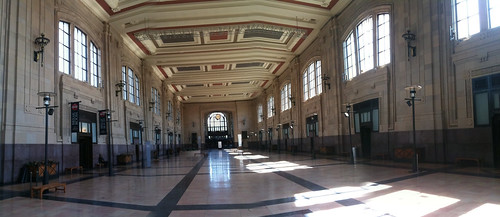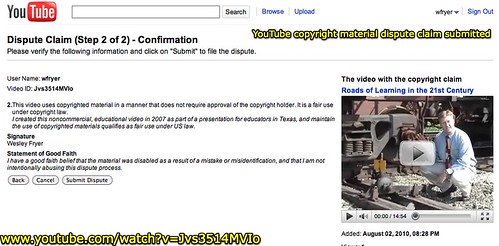This afternoon my girls and I were able to spend about an hour at Union Station in Kansas City, Missouri, along with my sister and nephew. In addition to having some fun taking composite cartwheel pictures using Pano, we also learned a bit about the amazing history of Union Station and trains in the Kansas City area. The following are two panoramic photos I took today with my iPhone, of the two main rooms within Union Station. The building was opened to the public in 1914 as the third largest train station in the country.
I’ve been fascinated by trains for years and the impact they’ve had in our communities and nation. In my fourth podcast ever, “Netflix – Google RSS Research – Trails, Trains, and T-1s” from August 2005, I reflected about these similarities and differences. It’s vital we bring high speed connectivity to all our communities, since it is the lifeline of commerce as well as education in the twenty-first century. Projects like “Google Fiber for Communities” are critical for this reason.
The statistic which really grabbed me in our cursory walk through the historical signage at Union Station today was the following: At the peak of its utilization, Union Station had 671 trains go through it in a SINGLE day. That is absolutely incredible! I don’t remember if that peak took place at the start of World War I for the United States, in 1917, or following World War II in 1945 when so many GIs were returning home. The official Union Station train history page doesn’t say. Whatever the case, it’s remarkable to contrast that quantity to the number of trains which pass through Union Station each day now: just SIX. What an incredible contrast!
Being around trains and thinking about the radical differences in train traffic in Kansas City from the 20th to the 21st centuries made me remember the fifteen minute video I created in May 2007, “Roads of Learning in the 21st Century.” I used that video as part of my keynote address shared over video from South Padre Island to teachers at ESC 10 in Richardson, Texas. Since YouTube just (on July 29th) increased the maximum number of minutes for uploaded videos to fifteen minutes, I uploaded and shared this 2007 video to my YouTube account this evening.
This video (as I noted in my original blog post when I shared it) definitely could have used several edits and improvements. I could have made my points more concisely, and kept the length down to less than ten minutes. Still, it was fun to make and hopefully was valuable to the teachers at ESC 10 in May 2007. Now, thanks to YouTube’s time length extension, it’s available on YouTube for potentially a larger audience. I wouldn’t say this is my “best work” in terms of videography, but the ideas are good and it’s worthwhile to reflect three years later on my thinking at the time about school reform, the importance of teachers as “connectors” for students, etc.
I included this reference in the original video and blog post, but it’s worth mentioning again that I was inspired to think about “learning on the rails” in this video by David Warlick‘s 2006 pre-conference keynote for the K-12 Online Conference. If you’ve never seen that presentation by David, “Derailing Education: Taking Sidetrips for Learning,” it’s well worth checking out. The video is 55 minutes long.
As a final sidebar to this post, I was surprised after uploading this video to YouTube to find my audio track had been disabled.
The reason for this was that I used an excerpt of a copyrighted song during part of the video, and YouTube’s saavy copyright-policing algorithms picked up on this. Very high tech – and with good reason, of course. I submitted a formal “copyright dispute” to claim a fair use exemption for the use of these copyrighted materials, and then the audio track was re-enabled on the video.
Very instructive.
“Learning on the rails.” That still describes the ways many schools, administrators, and teachers expect students to learn. Just as the travelers in the Kansas City metro area are no longer constrained to the rails of the railroad tracks when they want to see the world, we are not either as 21st century digital learners. Yes, we DO need gigabit fiber connections to our homes. As educators, we DO need to serve more as the “connectors” of digital content and expert voices for our students than simply expert oral communicators of knowledge. The informational transactions taking place at Union Station in Kansas City have undergone a complete transformation from the early part of the twentieth century when they began. Informational transactions in our classrooms need a similar transformation.
Technorati Tags:
administrator, city, classroom, education, history, k12online, kansas, kc, leadership, station, teacher, union, train, trains, kansascity, unionstation, k12online06, vision
If you enjoyed this post and found it useful, subscribe to Wes’ free newsletter. Check out Wes’ video tutorial library, “Playing with Media.” Information about more ways to learn with Dr. Wesley Fryer are available on wesfryer.com/after.
On this day..
- Choose Your Own Adventure YouTube Video: Lessons Learned – 2017
- Moving Students From Knowledgeable to Knowledge-ABLE: Michael Wesch at TEDxKC – 2014
- Left to Their Own Devices – 2013
- Help Shape the Vision of Oklahoma City Public Schools: Sunday August 4th – 2013
- Books on My Wish List Thanks to Bob Sprankle – 2012
- 12 Graphics to Illustrate Mapping Media to the Curriculum – 2012
- The phrase “CIPA compliant content” can be misleading – 2011
- iPad Apps for the classroom #blackfootETC – 2011
- Transformative Personal Connections in a Hyperconnected World #blackfootETC – 2011
- Show your remaining battery percentage on your iOS device (iPhone, iPad, etc) – 2010




